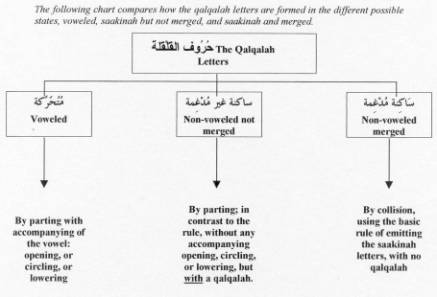|
|
|
|
|
Voweled
letters
|
Qalqalah |
Saakinah
letters
|
|
The are emitted by separation |
The are emitted by separation |
The are emitted by collision |
|
Accompanying
movement:
1.
Opening
of the mouth (for the fat-h)
2.
Circling
of the mouth for the dhammah
3.
Lowering
of the jaw for the kasrah |
Nothing |
Nothing
accompanies it( no mouth or jaw movement) |
From
this chart we can see that a qalqalah
letter is similar to a saakin
letter, in that there is no accompanying jaw and mouth movement with it.
On the other hand, it is unlike the saakin letter in that the qalqalah
is articulated by
separation
(
![]() )of the two parts of
articulation.
The qalqalah letter is similar to the voweled
letter since they both are articulated separation
)of the two parts of
articulation.
The qalqalah letter is similar to the voweled
letter since they both are articulated separation
(
![]() ) of the two parts of articulation,
but unlike it since the qalqalah has no accompanying jaw and mouth movement and the
voweled letter does.
) of the two parts of articulation,
but unlike it since the qalqalah has no accompanying jaw and mouth movement and the
voweled letter does.
The definition of qalqalah is as follows:
Its linguistic definition: shaking, disturbance
Its applied definition: Disturbance of the letter when it is in the state of being non-voweled until a strong accent is heard when it is articulated by parting of the two components of the articulating parts, not by collision, without accompanying it any opening of the mouth, or circling of the lips, or lowering of the jaw.
A
very important note: The qalqalah does not resemble
a fat-h or a dhammah
or a kasrah. It
does not follow the vowel of the preceding letter, nor the following letter.
If
the qalqalah letters have a shaddah
indicating merging of two of
the same letter (
![]() ),
the first letter of the shaddah (which is saakin) is then articulated by
collision, or
),
the first letter of the shaddah (which is saakin) is then articulated by
collision, or
![]() . For example:
. For example:
![]() and
and
![]() .
If we are stopping on the first word in the previous example, the
first
.
If we are stopping on the first word in the previous example, the
first
![]() of the word
of the word
![]() is
pronounced by collision, or
is
pronounced by collision, or
![]() , and the second
, and the second
![]() is
recited with a qalqalah. This
means that the qalqalah
is pronounced with
is
recited with a qalqalah. This
means that the qalqalah
is pronounced with
![]() without any accompanying mouth and jaw movement.
The
without any accompanying mouth and jaw movement.
The
![]() of
the word
of
the word
![]() would
be the same as the
would
be the same as the
![]() in
the word
in
the word
![]() .
.

The
Qalqalah is divided into two classes: The Lesser and Greater Qalqalah
The
Lesser Qalqalah
![]() : This
occurs when the qalqalah
in is the middle of a word, or at the end of a word, and we are not
stopping on that word. In this case we say the qalqalah, and immediately
proceed to the next letter, or word. i.e.
: This
occurs when the qalqalah
in is the middle of a word, or at the end of a word, and we are not
stopping on that word. In this case we say the qalqalah, and immediately
proceed to the next letter, or word. i.e.
![]() and
and
![]()
The
Greater Qalqalah
![]() : This
happens when the qalqalah is
the last letter of a word, and we are stopping on that word.
For example:
: This
happens when the qalqalah is
the last letter of a word, and we are stopping on that word.
For example:
![]() .
.
The
difference between the two divisions is that there is more of a ring to the greater
qalqalah
because we are stopping on it, than there is on the lesser qalqalah.